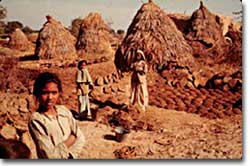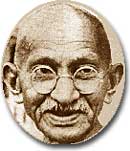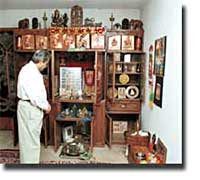8b. The Caste System

If a Hindu person were asked to explain the nature of the caste system, he or she might start to tell the story of Brahma — the four-headed, four-handed deity worshipped as the creator of the universe.
According to an ancient text known as the Rigveda, the division of Indian society was based on Brahma's divine manifestation of four groups.
Priests and teachers were cast from his mouth, rulers and warriors from his arms, merchants and traders from his thighs, and workers and peasants from his feet.
What does "Caste" Mean?

Although born into the Kshatriya caste, Mahatma Gandhi spent much of his life working to bring the Untouchables equality. It was Gandhi who first named the Untouchables "Harijans," meaning "children of God."
Others might present a biological explanation of India's stratification system, based on the notion that all living things inherit a particular set of qualities. Some inherit wisdom and intelligence, some get pride and passion, and others are stuck with less fortunate traits. Proponents of this theory attribute all aspects of one's lifestyle — social status, occupation, and even diet — to these inherent qualities and thus use them to explain the foundation of the caste system.
The Origins of the Caste System
According to one long-held theory about the origins of South Asia's caste system, Aryans from central Asia invaded South Asia and introduced the caste system as a means of controlling the local populations. The Aryans defined key roles in society, then assigned groups of people to them. Individuals were born into, worked, married, ate, and died within those groups. There was no social mobility.
This Indian immigrant is still conscious of his Brahman heritage. Here he is shown standing in front of an altar in his home in the United States.

This Indian immigrant is still conscious of his Brahman heritage. Here he is shown standing in front of an altar in his home in the United States.
The idea of an "Aryan" group of people was not proposed until the 19th century. After identifying a language called Aryan from which Indo-European languages are descended, several European linguists claimed that the speakers of this language (named Aryans by the linguists) had come from the north — from Europe.
Thus, according to this theory, European languages and cultures came first and were therefore superior to others. This idea was later widely promoted by Adolf Hilter in his attempts to assert the "racial superiority" of so-called light-skinned people from Europe over so-called dark-skinned people from the rest of the world — and thus provide justification for genocide.But 20th-century scholarship has thoroughly disproved this theory. Most scholars believe that there was no Aryan invasion from the north. In fact, some even believe that the Aryans — if they did exist — actually originated in South Asia and spread from there to Europe. Regardless of who the Aryans were or where they lived, it is generally agreed that they did not single-handedly create South Asia's caste system.
Thus, it has been impossible to determine the exact origins of the caste system in South Asia. In the midst of the debate, only one thing is certain: South Asia's caste system has been around for several millennia and, until the second half of the 20th century, has changed very little during all of that time.
Time for Class
In ancient India, the ranked occupational groups were referred to as varnas, and the hereditary occupational groups within the varnas were known as jatis. Many have immediately assumed that ascribed social groups and rules prohibiting intermarriage among the groups signify the existence of a racist culture. But this assumption is false. Varnas are not racial groups but rather classes.
Four varna categories were constructed to organize society along economic and occupational lines. Spiritual leaders and teachers were called Brahmins. Warriors and nobility were called Kshatriyas. Merchants and producers were called Vaishyas. Laborers were called Sudras.
The Untouchables
In addition to the varnas, there is a fifth class in Hinduism. It encompassed outcasts who, literally, did all the dirty work. They were referred to as "untouchables" because they carried out the miserable tasks associated with disease and pollution, such as cleaning up after funerals, dealing with sewage, and working with animal skin.
Brahmins were considered the embodiment of purity, and untouchables the embodiment of pollution. Physical contact between the two groups was absolutely prohibited. Brahmins adhered so strongly to this rule that they felt obliged to bathe if even the shadow of an untouchable fell across them.
Struggling against Tradition
Although the political and social force of the caste system has not disappeared completely, the Indian government has officially outlawed caste discrimination and made widespread reforms. Particularly through the efforts of Indian nationalists such as Mohandas Gandhi, rules preventing social mobility and cross-caste mingling have been loosened.
Gandhi renamed the untouchables Harijans, which means "the people of God." Adopted in 1949, the Indian Constitution provided a legal framework for the emancipation of untouchables and for the equality of all citizens.
In recent years, the Untouchables have become a politically active group and have adopted for themselves the name Dalits, which means "those who have been broken."







